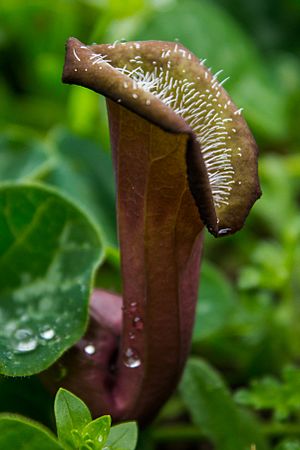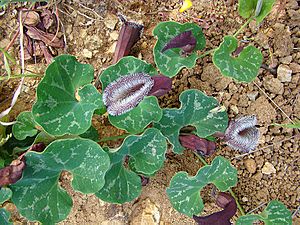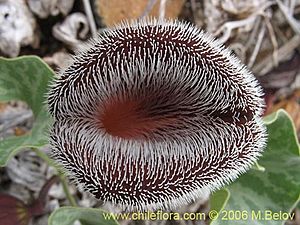Aristolochia chilensis facts for kids
Quick facts for kids Aristolochia chilensis |
|
|---|---|
 |
|
| Scientific classification | |
| Genus: |
Aristolochia
|
| Species: |
chilensis
|
The Aristolochia chilensis is a special plant from Chile. People often call it orejas de zorro, which means "fox ears," because of its unique shape. It's a type of plant that lives for many years and grows like a vine.
Contents
What is Aristolochia chilensis?
This plant is a vine that can grow up to about 3 feet (1 meter) long. Its climbing stems have leaves shaped like boomerangs. The flowers can be yellowish or brownish-purple. They give off a smell that isn't very nice, but this smell helps them attract flies. These flies are super important because they help the plant make seeds!
The flowers have tiny hairs that point downwards, a bit like those found in pitcher plants. These hairs make it hard for the flies to leave once they are inside the flower. While the flies are trapped, they help the plant by dropping off pollen they carried from other flowers and picking up new pollen from this one. The flower gives the flies some sweet nectar to eat for about a day. After that, the flower starts to wilt, and the hairs relax, letting the flies go free to visit other flowers. The flowers usually grow between 6 to 12 inches (15 to 30 cm) tall.
How is it Special?
Plants in the Aristolochia family, like the "fox ears" plant, are famous for how they use flies for pollination. They might remind you of pitcher plants or flytraps. But there's a big difference! Pitcher plants and flytraps eat insects for food. Aristolochia plants, however, only use the insects to help them spread their pollen.
It's important to know that every part of this plant is poisonous if humans or animals eat it. But some creatures, like caterpillars and the swallowtail butterfly, can actually eat its leaves and flowers! These caterpillars can handle the plant's natural acids. In fact, eating the plant makes the caterpillars poisonous to animals that might try to eat them. The flower also has a special shape (it's called zygomorphic, meaning it's symmetrical in only one way) and often smells bad to attract flies, but also to keep other animals away. This strong smell helps the plant survive.
Where Does it Live?
This plant only grows in Chile. You can find it in low valleys and along the coastal mountains. It likes to grow in coastal areas from sea level up to about 1,640 feet (500 meters) high. In the mountains, it can be found from about 1,640 feet (500 meters) up to 6,560 feet (2,000 meters).
Aristolochia chilensis loves very dry places with little rain and can handle long periods without water. It needs lots of sunlight and grows best on flat ground or slopes that face north. It can't handle snow, but it can survive short freezing times, like morning frost, when temperatures drop to about 23°F (-5°C). It also needs soil that drains water well to grow properly.
Its Role in Nature
The Aristolochia chilensis plant is a very important food source for the young caterpillars of the gold rim swallowtail butterfly, called Battus polydamas. Another similar plant, Aristolochia bridgesii, also feeds these butterflies.
Uses and Special Chemicals
People sometimes grow Aristolochia chilensis as an ornamental plant because it looks interesting. It can be used as a groundcover in gardens that don't need much water (this is called xeriscaping).
This plant contains a chemical called aristolochic acid. In the past, this acid was used in some traditional medicines, for things like mouth sores or arthritis. However, scientists later found that these acids can be very harmful. They can cause cancer, change a person's genes, and damage the kidneys. Because of these dangers, the use of aristolochic acid in medicines has been banned in many places, including Europe since 2001 and China since 2003.
See also
 In Spanish: Oreja de zorro para niños
In Spanish: Oreja de zorro para niños



